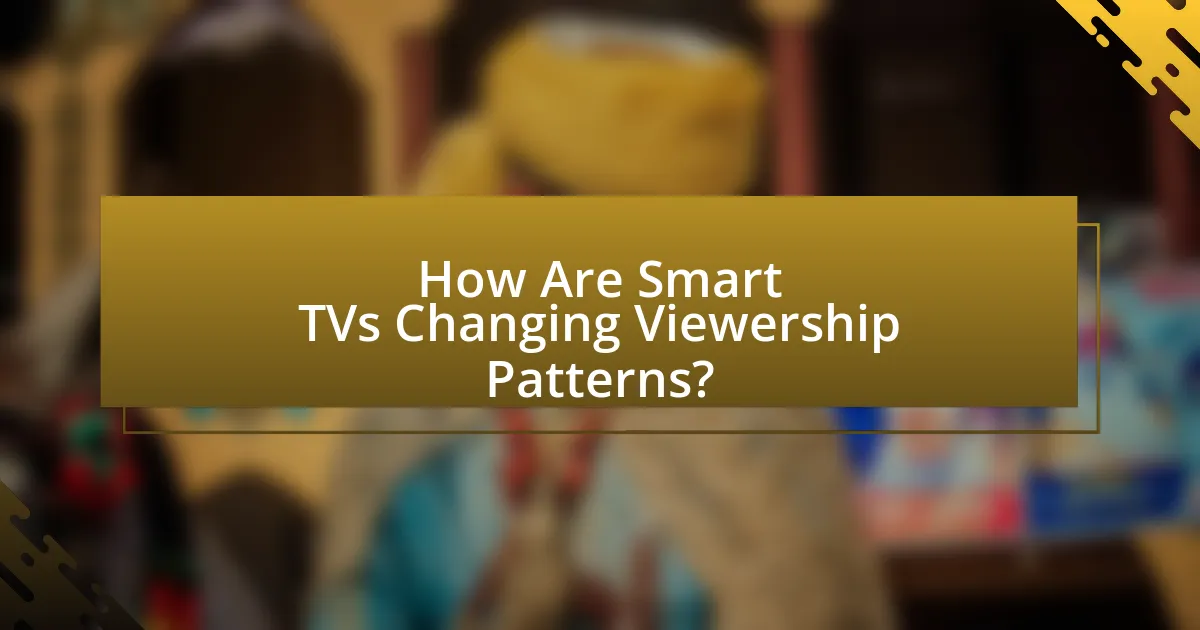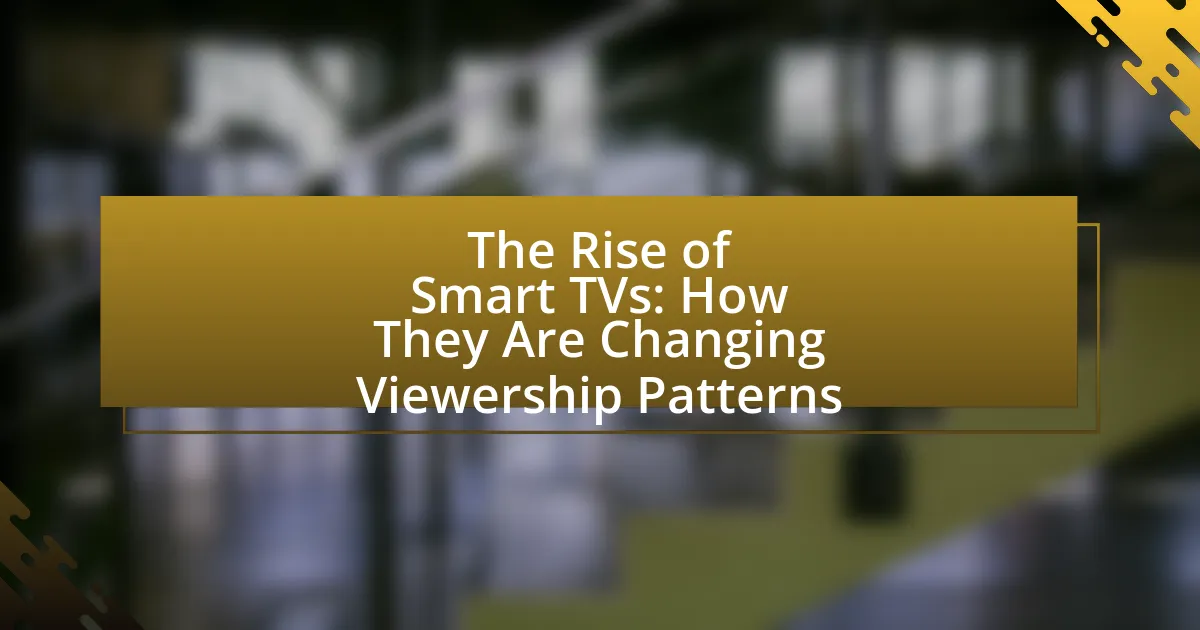Smart TVs are internet-connected televisions that integrate streaming services, apps, and web browsing capabilities, fundamentally altering how content is consumed. Since their emergence in the early 2000s, Smart TVs have gained significant traction, with over 80% of U.S. households owning one by 2023. This article explores the differences between Smart TVs and traditional televisions, the features that define them, and the technological advancements that support their functionality. It also examines the impact of Smart TVs on viewership patterns, including the shift towards on-demand content, the influence of streaming services, and the challenges associated with privacy and security. Additionally, the article discusses future trends in Smart TV technology and content consumption, highlighting the evolving landscape of media engagement.

What are Smart TVs and How Have They Emerged?
Smart TVs are internet-connected televisions that integrate streaming services, apps, and web browsing capabilities, allowing users to access a wide range of content beyond traditional broadcast channels. They emerged in the early 2000s, with significant advancements occurring around 2010 when manufacturers like Samsung and LG began incorporating smart features into their TV models. By 2020, over 50% of televisions sold globally were smart TVs, reflecting a shift in consumer preferences towards on-demand content and interactive features. This evolution has transformed viewership patterns, as audiences increasingly favor streaming platforms over cable subscriptions, leading to a decline in traditional TV viewing.
How do Smart TVs differ from traditional televisions?
Smart TVs differ from traditional televisions primarily by their ability to connect to the internet and run applications. This connectivity allows Smart TVs to stream content from various online platforms like Netflix and Hulu, whereas traditional televisions typically require external devices such as DVD players or streaming boxes to access similar content. According to a report by Statista, as of 2023, over 80% of households in the U.S. own a Smart TV, highlighting their growing prevalence and the shift in viewership patterns towards internet-based content consumption.
What features make Smart TVs ‘smart’?
Smart TVs are considered ‘smart’ due to their ability to connect to the internet and run applications, enabling streaming services, web browsing, and access to various online content. These features include built-in Wi-Fi, support for streaming platforms like Netflix and Hulu, voice control capabilities, and integration with smart home devices. For instance, according to a report by Statista, as of 2021, over 80% of U.S. households owned at least one smart TV, highlighting their prevalence and the demand for internet connectivity and app functionality in modern television viewing.
How has technology evolved to support Smart TVs?
Technology has evolved significantly to support Smart TVs through advancements in internet connectivity, processing power, and user interface design. High-speed internet access, including fiber-optic and 5G networks, has enabled seamless streaming of high-definition content. Additionally, the integration of powerful processors and graphics capabilities in Smart TVs allows for smooth multitasking and enhanced visual experiences. User interfaces have also improved, with intuitive navigation and voice control features, making it easier for users to access a variety of streaming services and applications. These developments have collectively transformed Smart TVs into central hubs for entertainment, reflecting changing viewership patterns where consumers increasingly prefer on-demand content over traditional broadcasting.
Why is the rise of Smart TVs significant in today’s media landscape?
The rise of Smart TVs is significant in today’s media landscape because they integrate internet connectivity with traditional television, transforming how content is consumed. Smart TVs enable users to access streaming services, social media, and apps directly on their screens, which has led to a shift from linear television viewing to on-demand content consumption. According to a report by Statista, as of 2023, over 50% of households in the United States own a Smart TV, indicating a substantial change in viewer preferences. This shift has prompted traditional broadcasters to adapt their strategies, focusing more on digital content and interactive features to engage audiences effectively.
What trends in consumer behavior are driving Smart TV adoption?
The primary trend driving Smart TV adoption is the increasing demand for streaming services and on-demand content. Consumers are shifting away from traditional cable subscriptions in favor of platforms like Netflix, Hulu, and Amazon Prime Video, which are easily accessible through Smart TVs. According to a 2022 report by Statista, over 80% of U.S. households subscribed to at least one streaming service, highlighting a significant change in viewing preferences. Additionally, the integration of smart features, such as voice control and app ecosystems, enhances user experience, making Smart TVs more appealing. This trend is further supported by the rise of mobile device usage, as consumers seek seamless connectivity between their devices and televisions.
How do Smart TVs influence content consumption patterns?
Smart TVs significantly influence content consumption patterns by enabling on-demand access to a wide variety of streaming services and applications. This shift allows viewers to choose what to watch and when, moving away from traditional scheduled programming. According to a report by Nielsen, 70% of U.S. households now have a Smart TV, which has led to a 30% increase in streaming content consumption over the past five years. This accessibility encourages binge-watching behaviors and increases the overall time spent on video content, as users can easily switch between platforms like Netflix, Hulu, and YouTube.

How Are Smart TVs Changing Viewership Patterns?
Smart TVs are significantly altering viewership patterns by enabling on-demand content access and integrating streaming services directly into the television experience. This shift has led to a decline in traditional cable subscriptions, with a report from eMarketer indicating that in 2023, over 50% of U.S. households have cut the cord, favoring streaming platforms like Netflix and Hulu. Additionally, Smart TVs facilitate personalized viewing experiences through algorithms that recommend content based on user preferences, further enhancing viewer engagement. As a result, audiences are increasingly consuming content at their convenience, leading to a rise in binge-watching behaviors and a diversification of viewing habits across various demographics.
What impact do Smart TVs have on traditional viewing habits?
Smart TVs significantly alter traditional viewing habits by enabling on-demand content access and streaming services, which reduces reliance on scheduled programming. Research indicates that 82% of households with Smart TVs use them to stream content, leading to a decline in live TV viewership. This shift is evidenced by a 2021 Nielsen report showing that traditional TV viewing dropped by 10% as more viewers opted for streaming platforms like Netflix and Hulu, which offer personalized viewing experiences. Consequently, Smart TVs are reshaping how audiences consume media, favoring flexibility and convenience over conventional broadcast schedules.
How do Smart TVs facilitate on-demand content access?
Smart TVs facilitate on-demand content access by integrating internet connectivity and streaming applications directly into the television. This allows users to access a wide range of content from platforms like Netflix, Hulu, and Amazon Prime Video without the need for additional devices. According to a report by Statista, as of 2023, over 80% of households in the U.S. own a Smart TV, highlighting their prevalence and the shift towards streaming services as primary content sources.
What role do streaming services play in changing viewership?
Streaming services significantly alter viewership by providing on-demand access to a vast array of content, which shifts consumer behavior from traditional scheduled programming to binge-watching and personalized viewing experiences. This transition is evidenced by a 2021 report from Nielsen, which indicated that streaming accounted for 28% of total TV viewing time in the U.S., surpassing cable for the first time. Additionally, the flexibility of streaming platforms allows viewers to watch content anytime and anywhere, further enhancing their engagement and altering traditional viewing habits.
How do Smart TVs affect social viewing experiences?
Smart TVs enhance social viewing experiences by enabling interactive features and access to streaming services that facilitate shared viewing. These devices allow users to watch content simultaneously while engaging in real-time discussions through integrated social media platforms or messaging apps. Research indicates that 70% of viewers prefer to watch shows with others, and Smart TVs support this by providing features like screen sharing and synchronized viewing options, which promote a communal atmosphere. Additionally, Smart TVs often include applications that allow users to connect with friends and family, further enriching the social aspect of viewing.
What features enhance shared viewing among users?
Features that enhance shared viewing among users include synchronized playback, integrated chat functions, and multi-device connectivity. Synchronized playback allows multiple users to watch the same content simultaneously, creating a cohesive viewing experience. Integrated chat functions enable real-time communication among viewers, fostering interaction and engagement during the viewing session. Multi-device connectivity ensures that users can join the shared viewing experience from various devices, such as smartphones, tablets, or smart TVs, making it accessible and convenient. These features collectively improve the social aspect of viewing, as evidenced by studies showing that shared viewing experiences increase user satisfaction and engagement.
How do Smart TVs integrate social media into viewing experiences?
Smart TVs integrate social media into viewing experiences by allowing users to access social media platforms directly through their television interface. This integration enables viewers to share their thoughts on shows in real-time, interact with friends, and view social media feeds while watching content. For instance, many Smart TVs support apps like Facebook and Twitter, which can display notifications or allow users to post comments about what they are watching. According to a report by Nielsen, 60% of viewers engage with social media while watching TV, indicating a significant trend in how social media enhances the viewing experience.

What Challenges and Considerations Come with Smart TV Adoption?
Smart TV adoption presents several challenges and considerations, including privacy concerns, security vulnerabilities, and compatibility issues. Privacy concerns arise as smart TVs often collect user data for targeted advertising, leading to potential misuse of personal information. Security vulnerabilities are significant, as these devices can be susceptible to hacking, exposing users to unauthorized access and control. Compatibility issues may occur when integrating smart TVs with existing home networks and devices, potentially complicating user experience. According to a 2021 report by the Consumer Technology Association, 70% of consumers expressed concerns about data privacy related to smart devices, highlighting the importance of addressing these challenges in the adoption process.
What privacy concerns are associated with Smart TVs?
Smart TVs pose significant privacy concerns primarily due to their ability to collect and transmit user data. These devices often track viewing habits, personal preferences, and even voice commands, which can lead to unauthorized data sharing with third parties. For instance, a 2020 study by the Electronic Frontier Foundation highlighted that many Smart TVs come with built-in tracking features that can monitor user behavior and send this information to advertisers without explicit consent. Additionally, vulnerabilities in Smart TV software can expose users to hacking risks, allowing unauthorized access to personal information.
How do Smart TVs collect and use viewer data?
Smart TVs collect viewer data through various methods, including internet connectivity, built-in cameras, and microphones. These devices track user interactions, such as viewing habits, preferences, and search queries, to create personalized content recommendations and targeted advertisements. For instance, a study by the Consumer Technology Association found that 70% of Smart TV users are aware that their viewing data is collected, which supports the notion that data collection is a common practice among these devices. Additionally, manufacturers often share this data with third-party advertisers to enhance ad targeting, thereby increasing revenue opportunities.
What steps can users take to protect their privacy?
Users can protect their privacy by adjusting the privacy settings on their smart TVs. This includes disabling data collection features, opting out of targeted advertising, and limiting the sharing of viewing habits with third parties. Research indicates that many smart TVs collect user data for personalized advertising, which can be mitigated by reviewing and modifying privacy settings in the device’s menu. Additionally, users should regularly update their TV’s firmware to patch security vulnerabilities, as outdated software can expose personal information to potential breaches.
What technical issues might users face with Smart TVs?
Users of Smart TVs may encounter several technical issues, including connectivity problems, software glitches, and compatibility issues with apps. Connectivity problems often arise from unstable Wi-Fi connections, which can lead to buffering or inability to stream content. Software glitches may manifest as slow performance or crashes, particularly after updates, which can disrupt the viewing experience. Additionally, compatibility issues can occur when certain apps are not supported on specific Smart TV models, limiting access to desired content. These issues are commonly reported in user reviews and technical support forums, highlighting the challenges faced by Smart TV users.
How can users troubleshoot common Smart TV problems?
Users can troubleshoot common Smart TV problems by following a systematic approach. First, they should check the internet connection, as many issues stem from connectivity problems; ensuring a stable Wi-Fi signal or using an Ethernet cable can resolve streaming issues. Next, users should restart the Smart TV, as this can clear temporary glitches. If the TV is unresponsive, performing a factory reset may be necessary, which restores original settings and can fix persistent software issues. Additionally, users should ensure that the TV’s software is up to date, as manufacturers frequently release updates to improve performance and fix bugs. Lastly, consulting the user manual or the manufacturer’s support website can provide specific troubleshooting steps tailored to the model in question.
What are the best practices for maintaining a Smart TV?
To maintain a Smart TV effectively, users should regularly update the software, clean the screen with appropriate materials, and manage storage by uninstalling unused apps. Regular software updates ensure that the TV operates with the latest features and security patches, which is crucial for performance and safety. Cleaning the screen with a microfiber cloth prevents scratches and maintains picture quality, while managing storage helps in optimizing the device’s speed and functionality. According to a study by the Consumer Technology Association, proper maintenance can extend the lifespan of electronic devices, including Smart TVs, by up to 30%.
What are the future trends for Smart TVs and viewership patterns?
Future trends for Smart TVs include increased integration of artificial intelligence, enhanced user personalization, and a shift towards streaming services over traditional cable. Smart TVs are expected to leverage AI to provide tailored content recommendations based on viewer preferences, which can lead to higher engagement rates. According to a report by Statista, the global Smart TV market is projected to grow significantly, with an estimated 1.5 billion units expected to be in use by 2025. Additionally, viewership patterns are shifting as consumers increasingly favor on-demand streaming platforms, with a Nielsen report indicating that streaming accounted for over 30% of total TV viewing time in 2022. This trend suggests that Smart TVs will continue to evolve as central hubs for accessing diverse content, further altering how audiences consume media.
How might advancements in technology further change Smart TV capabilities?
Advancements in technology will likely enhance Smart TV capabilities by integrating artificial intelligence, improving user interfaces, and expanding connectivity options. For instance, AI can enable personalized content recommendations based on viewing habits, making it easier for users to discover new shows and movies. Additionally, advancements in voice recognition technology will allow for more intuitive control of Smart TVs, facilitating hands-free operation and enhancing user experience. Furthermore, the development of 5G technology will provide faster internet speeds, enabling seamless streaming of high-definition content and supporting more connected devices in smart homes. These technological improvements are supported by industry trends indicating a growing demand for smarter, more interactive viewing experiences, as evidenced by the increasing adoption of AI-driven features in consumer electronics.
What emerging content formats could influence future viewership?
Emerging content formats that could influence future viewership include interactive streaming, augmented reality (AR) experiences, and short-form video content. Interactive streaming allows viewers to engage with content in real-time, enhancing user experience and retention; platforms like Twitch exemplify this trend. Augmented reality experiences, such as those seen in mobile apps and AR-enabled smart TVs, provide immersive storytelling that captivates audiences, as evidenced by the growing popularity of AR in advertising and entertainment. Additionally, short-form video content, popularized by platforms like TikTok, caters to decreasing attention spans and has led to increased engagement, with reports indicating that 67% of users prefer bite-sized content. These formats are reshaping how audiences consume media, driven by technological advancements and changing viewer preferences.
What tips can enhance the Smart TV viewing experience?
To enhance the Smart TV viewing experience, users should optimize their internet connection, adjust display settings, and utilize streaming services effectively. A stable and high-speed internet connection is crucial, as Smart TVs rely on streaming content, and buffering can disrupt viewing. Adjusting display settings, such as brightness, contrast, and color calibration, can significantly improve picture quality, making content more enjoyable. Additionally, leveraging features like voice control and personalized recommendations from streaming services can streamline navigation and enhance user engagement, as studies show that tailored content increases viewer satisfaction.

Leave a Reply